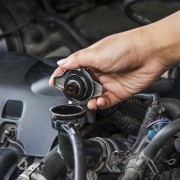You want wheels that serve you well. Even the hottest sports car won't handle properly and safely if you ignore these essential components. Here's some maintenance advice for your wheels to help them last.
- Browse Categories
- All Tips
-
Home & Garden
- All
- Appliances
- Bathroom
- Cleaning
- Crafts
- Decorating
- Electrical
- Flooring
- Furniture
- Garage Door
- Gardening
- Green Living
- Heating
- Home Alarm Systems
- Home Maintenance
- Home Remedies
- Home Security
- Home Staging
- House Sitting
- Junk Removal
- Kitchen
- Lawn Care
- Lock Systems
- Moving
- Outdoor Living
- Pest Control
- Plumbing
- Renovation
- Roofing
- Snow Removal
- Storage
- Tools
- Tree Service
- Health
- Family
- Travel
- Auto
- More Tips

How to make your wheels and hubcaps last
July 29, 2015

Use wheel cleaner
- Your car's wheels are down there on the road, taking the brunt of road dirt. Add in the dust that wears off your brake pads and you've got a formula for stains that are tough to remove when you wash your vehicle.
- Car-washing liquid won't do the job. You need a wheel cleaner specifically formulated to remove such stains.
- Be sure to buy the correct formulation. Some cleaners are designed for metal wheels, and others for painted or clear-coated wheels.
- The metal wheel cleaners come in various formulations as well, depending upon whether your metal wheel has a satin, aluminum or chrome finish.
- Protect metal wheels with wheel polish, painted wheels with a coat of wax.
Have wheel alignment checked
- Have your car's wheel alignment checked every 48,000 kilometres (30,000 miles), or as recommended in your owner's manual.
- Also have it checked after buying new tires and when you replace a rack-and-pinion steering unit or other steering parts.
- Improper tire alignment will shorten the life of your tires as well as cause poor handling.
- If your steering is stiffer than normal or the vehicle pulls to one side, you probably have an alignment problem.
Lube your lug nuts
- Lug nuts, if not lubricated occasionally, can seize or "freeze" to the studs due to corrosion. Repairing them can be expensive.
- Having to call a tow truck for a flat you can't remove is even more expensive.
- The next time you change or rotate your tires, pick up some anti-seize lubricant at your local auto supply store.
- Clean the stud threads with a wire brush and wipe them with the lubricant.
- It's formulated to prevent the lug nuts (spark plugs, too) from seizing and won't allow them to loosen as you drive, the way other lubricants might.
- If a lug nut does freeze to a stud, try spraying the nut and stud with oil lubricant.
- Allow it to penetrate for 10 or 20 minutes. Use a heat gun to apply heat. Then use a ratchet wrench to remove the lug.
Hang on to your hubcaps
Clang, clang, clang! There goes your hubcap, rolling off to destinations unknown. Hubcaps, wheel covers and centre caps can pop off your car's wheels as you're driving if they were not reinstalled correctly, have loosened over time, or if they were damaged by being jammed against a curb while parking. Here are some things you can do to keep these expensive parts on the car:
• If your older metal hubcap has loosened, remove it and pry the metal clips outward slightly. This should fix the problem.
• Newer plastic-type hubcaps and some wheel covers are usually held in place by a retaining wire ring that snaps into tabs on the wheel. When installing such a cap or cover, take care that you do not bend or break the tabs.
• One way to make sure your expensive hubcaps aren't damaged by a repair shop is to remove them yourself before taking your car in for a repair that requires wheel removal, such as a brake job or new tires. When reinstalling hubcaps, rest the hubcap in place and then tap it gently with a rubber mallet. Don't hit the hubcap hard, or you might break the clips underneath. If you prefer to have your repairperson remove the covers, check to make sure they were reinstalled properly. They should look even and flush.






